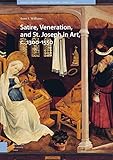Satire, Veneration, and St. Joseph in Art, c. 1300-1550 / Anne Williams.
Material type: TextSeries: Visual and Material Culture, 1300 -1700 ; 16Publisher: Amsterdam : Amsterdam University Press, [2019]Copyright date: ©2019Description: 1 online resource (244 p.)Content type:
TextSeries: Visual and Material Culture, 1300 -1700 ; 16Publisher: Amsterdam : Amsterdam University Press, [2019]Copyright date: ©2019Description: 1 online resource (244 p.)Content type: - 9789048534111
- online - DeGruyter
| Item type | Current library | Call number | URL | Status | Notes | Barcode | |
|---|---|---|---|---|---|---|---|
 eBook
eBook
|
Biblioteca "Angelicum" Pont. Univ. S.Tommaso d'Aquino Nuvola online | online - DeGruyter (Browse shelf(Opens below)) | Online access | Not for loan (Accesso limitato) | Accesso per gli utenti autorizzati / Access for authorized users | (dgr)9789048534111 |
Browsing Biblioteca "Angelicum" Pont. Univ. S.Tommaso d'Aquino shelves, Shelving location: Nuvola online Close shelf browser (Hides shelf browser)

|

|

|

|

|

|

|
||
| online - DeGruyter Urban Development in the Margins of a World Heritage Site : In the Shadows of Angkor / | online - DeGruyter Anticipating Sin in Medieval Society : Childhood, Sexuality, and Violence in the Early Penitentials / | online - DeGruyter Rereading Huizinga : Autumn of the Middle Ages, a Century Later / | online - DeGruyter Satire, Veneration, and St. Joseph in Art, c. 1300-1550 / | online - DeGruyter Neighbourhoods for the City in Pacific Asia / | online - DeGruyter The End of Silence : Accounts of the 1965 Genocide in Indonesia / | online - DeGruyter Divine and Demonic Imagery at Tor de'Specchi, 1400-1500 : Religious Women and Art in 15th-century Rome / |
Frontmatter -- Table of Contents -- List of Illustrations -- Acknowledgements -- Introduction -- 1. Joseph's Hosen, Devotion, and Humor: The 'Domestic' Saint and the Earliest Material Evidence of His Cult -- 2. Satire Sacred and Profane -- 3. Urbanitas, the Imago Humilis, and the Rhetoric of Humor in Sacred Art -- 4. The Miserly Saint and the Multivalent Image: Sanctity, Satire, and Subversion -- Conclusion -- Index
restricted access online access with authorization star
http://purl.org/coar/access_right/c_16ec
Satire, Veneration, and St. Joseph in Art, c. 1300-1550 is the first to reclaim satire as a central component of Catholic altarpieces, devotional art, and veneration, moving beyond humor's relegation to the medieval margins or to the profane arts alone. The book challenges humor's perception as a mere teaching tool for the laity and the antithesis of 'high' veneration and theology, a divide perpetuated by Counter-Reformation thought and the inheritance of Mikhail Bakhtin (Rabelais and His World, 1965). It reveals how humor, laughter, and material culture played a critical role in establishing St. Joseph as an exemplar in western Europe as early as the thirteenth century. Its goal is to open a new line of interpretation in medieval and early modern cultural studies, by revealing the functions of humor in sacred scenes, the role of laughter as veneration, and the importance of play for pre-Reformation religious experiences.
Mode of access: Internet via World Wide Web.
In English.
Description based on online resource; title from PDF title page (publisher's Web site, viewed 02. Mrz 2022)


